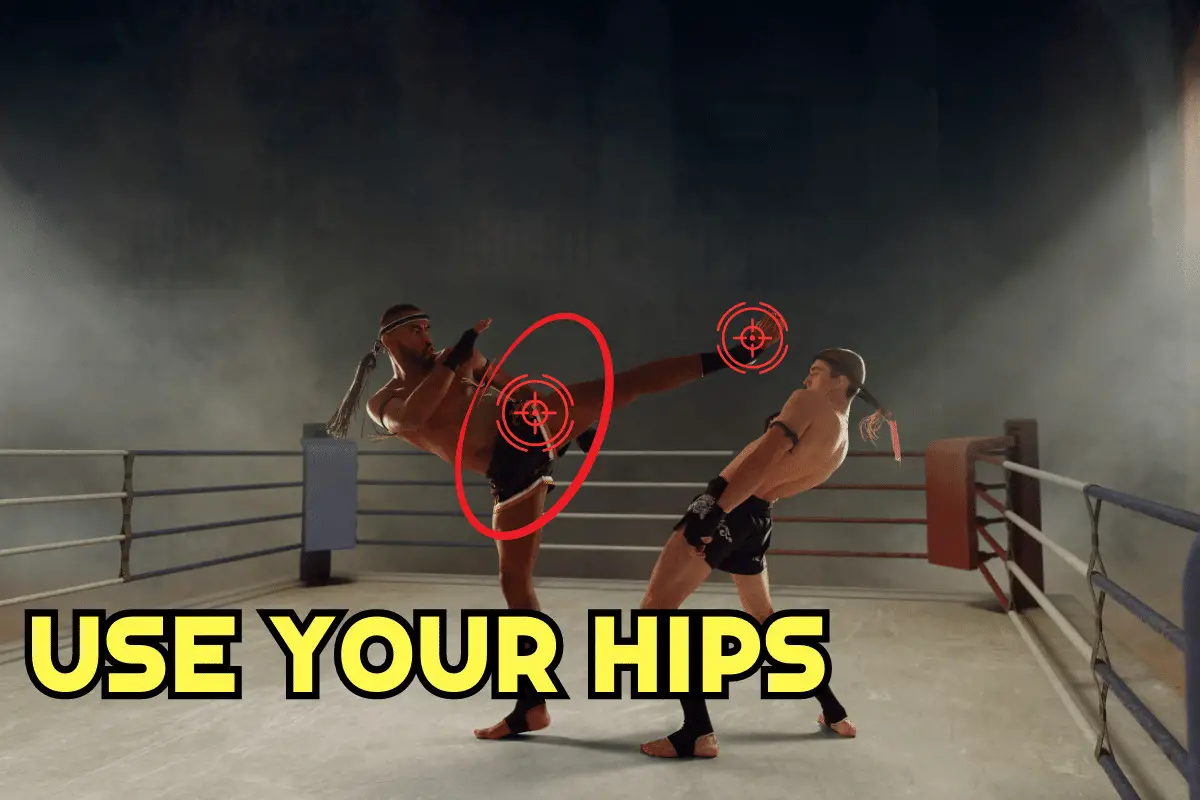Muay Thai is one of the best martial arts out there. It also involves an endless number of types of kicks, which you want to learn since they’ll boost your fighting skills by a long shot. One of the more popular ones is the Diagonal Kick, aka Side Kick, which we’ll cover in this article!
In Muay Thai and all other martial arts, the Diagonal Kick is a powerful striking technique that targets the opponent’s midsection or legs. It is commonly known as the “Side Kick” or “Diagonal Roundhouse Kick.” This technique involves a rotational movement of the hips and a sweeping motion of the leg to generate maximum power.
What you’ll learn to do in this article is to perform it flawlessly. If you follow along and implement everything we’ll discuss here, I’m confident you’ll become a solid user of this kick.
And as you’ll see very soon, this kick is exceptionally powerful. Therefore, not only will you be able to cause a lot of damage, but you’ll also remain relatively safe in the process. Defense is as important as offense, so not being as vulnerable can be the difference between losing and winning a fight.
The first part of this article is perhaps the most important one. However, in the second and third, we’ll cover very important subjects, which are combinations and variations. If you wish to skip through, you can follow the links to do so.
How to Perform the Side (Diagonal) Kick
This part of the article is the most important, so I want you to pay close attention here. If there’s anything you want to take from this guide, it’s this.
What we’ll do is break down the six steps to throw a fierce Diagonal Kick. If you don’t perform one of the steps correctly or skip performing it, the amount of force you’ll be able to generate won’t be as substantial as it could have been.
Thus, it’s critical you follow along and pay attention to everything written in the following points.
I encourage all of you to bookmark this article. If you’re serious about your training, you’ll want to have this article in easy access, as there’s no way you remember everything by heart.
Alright. Let’s dive in!
#1 – Start from a proper fighting stance
The first step is to start with a proper fighting stance. This can be difficult to understand for some; however, let me be clear—the way you stand before throwing the punch has a great influence on the power and speed you’ll be able to generate.
So the first step is to perfect your fighting stance. If you think yours isn’t perfect, I wrote a complete guide to perfecting your fighting stance, which you should definitely read.
Stand with your feet shoulder-width apart, one foot slightly forward and the other foot turned outward at a 45-degree angle. Your knees should be slightly bent, and your hands should be up guarding your face.
Remember, your fighting stance will influence the amount of power and speed you’ll be able to generate.
#2 – Chamber your kicking leg
The second step to execute a fierce Diagonal Kick is to chamber your kicking leg. What does that mean? Well, before you extend your leg toward the opponent, which is the shiniest step, you want to bend your knee and raise it.
Lift your rear leg, bending it at the knee, while maintaining your balance and keeping your upper body stable. The knee of your kicking leg should be pointing in the direction of your target.
Raising your knee before you extend your kicking leg—is massively beneficial to how much power you generate. This, by the way, applies to most kicks in most martial arts, including Kickboxing, Taekwondo, MMA, and Muay Thai.

#3 – Rotate your hips
The 3rd step in our guide is to rotate your hips. You should do that once you already have raised your knee. This and the 6th step compete for the step that more fighters skip. So if you want to be better than most fighters, make sure to follow along.
Initiate the kick by rotating your hips and torso toward the side you’re targeting. Pivot on the ball of your support foot (the foot that remains on the ground) to generate power for the kick. This rotation is crucial for transferring the power generated by your core muscles into the kick.
Make sure to go through with this step if you want to generate substantial damage with your Side Kick. It’ll be very difficult to cause a lot of damage without using your hips and body rotation for momentum.

#4 – Extend your kicking leg
As you rotate your hips, explosively extend your kicking leg outward in a diagonal path. Aim to strike the target with either your shin or the instep of your foot, depending on the situation. For example, if you’re targeting the opponent’s midsection, aim to hit with your shin.
You also want to select your target before you extend your kicking leg. This is critical for hitting the opponent where it hurts most. Primarily, you should aim for the midsection and liver for maximum damage and effectiveness with the Diagonal Kick. However, if you’re capable of hitting your opponent’s head, by all means, go for it.
#5 – Follow-through
Upon making contact with the target, quickly retract your leg back to the chambered position. This ensures that you maintain your balance and can quickly transition to your next move.
What you want to prevent from happening is hitting the opponent and being messy afterward. If that’ll be the case, your opponent will be more likely to attack effectively, which you want to avoid at all costs.
Thus, make sure to retract your leg back to the chambered position once you make contact.
#6 – Retract and Defend
The last step is something many fighters forget to do. The final step is to retract your leg smoothly, return to your fighting stance, and defend yourself. It’s also critical you keep your guard up throughout the entire execution.
Many fighters tend to forget to keep their guard up. As a result, their opponents are able to counter effectively most of the time, even if they’re successful with the Side Kick. Therefore, make sure to defend yourself properly.
You now know everything you need to throw a perfect Side Kick, aka Diagonal Kick. Whatever you call it, you must implement everything you’ve learned here, as that’s the only way you’ll learn.
And now, let’s dive into the 2nd part of the article.
Side Kick Combinations
Knowing to combine techniques in Muay Thai is critical. If you don’t know anything about fighting yet, combining techniques is what allows fighters to cause tons of damage quickly. I always say this: imagine not being able to throw more than a single strike at a time; the amount of damage you’ll cause will be substantially lower.
Thus, knowing to combine techniques is extremely important to your Muay Thai fighting career. Here are some of the best ones that involve the Side Kick:
- Jab–Cross-Side Kick:
- Start with a jab (left straight punch) to the opponent’s face.
- Follow up with a cross (right straight punch) to create an opening.
- Immediately after the cross, rotate your hips and deliver a powerful Side Kick to the opponent’s midsection or legs.
- Teep-Diagonal Kick:
- Use a teep (push kick) to create distance and disrupt your opponent’s balance. Push forward with your lead leg, extending your foot and pushing with the ball of your foot.
- As your opponent reacts to the teep, quickly transition into a Diagonal Kick, targeting their exposed midsection or legs.
- Hook-Diagonal Kick:
- Throw a hook punch with your lead hand, aiming for your opponent’s head or body.
- As your hook punch lands or creates an opening, immediately follow it up with a Diagonal Kick, driving your rear leg forward to strike the opponent’s midsection or legs.
- Cross-Hook-Side Kick:
- Begin with a cross (right straight punch) to the opponent’s face.
- Follow it up with a hook punch (left circular punch) to the head or body.
- Capitalize on the opening created by the hook punch by transitioning smoothly into a powerful Side Kick with your rear leg.
Diagonal Kick Variations
Learning more versions of the Side Kick will be exceptionally rewarding in the long term for your fighting career. Not only will you be able to diversify your fighting skills, but you’ll also be able to become a more confident fighter, which is key to success.
So learning more variations of any technique you learn in Muay Thai is critical to your long-term progression. Now that we know that, let’s cover some of the best variations of the Diagonal Kick in Thai Boxing, aka the art of 8-limbs!
- Side Thrust Kick:
- This is a basic variation of the Side Kick where you extend your leg out horizontally while keeping your toes pointing forward.
- Push your heel forward, aiming to strike the opponent’s midsection or ribs with the side of your foot.
- Retract your leg immediately after making contact to maintain balance and readiness for the next move.
- Oblique Kick:
- The oblique kick, also known as the stomp kick or shin kick, involves striking your opponent’s thigh or knee with a downward and inward motion.
- Lift your leg and drive the heel or the lower part of your shin downwards and diagonally towards the opponent’s lead leg, aiming for the thigh or knee.
- The oblique kick is used to disrupt your opponent’s balance and cause damage to their lead leg.
- Diagonal Side Kick:
- This variation combines the Side Kick with a diagonal trajectory, similar to the diagonal kick discussed earlier.
- Instead of extending your leg straight out, angle it slightly upward or downward, creating a diagonal path as you strike.
- This kick can be aimed at different targets, including the midsection, ribs, or even the head depending on the situation.
- Jumping Side Kick:
- The jumping Side Kick involves adding a jump or hop to generate additional power and surprise your opponent.
- As you jump, extend your leg out to the side and kick with the side of your foot or heel, targeting the opponent’s midsection or ribs.
- This technique requires good timing and control to execute effectively
Final Words
I’ve had a lot of fun researching and writing this article. Kicks are extremely important, especially in a martial art that consists of a lot of kicking. Therefore, I believe this article is extremely important to those who want to take their Muay Thai fighting skills to the next level.
Your next step now is to get in the gym and practice. I know it can be hard to step out of your comfort zone and start training something new. However, the benefits of this are immense. Not only might you fall in love with a new sport or technique, but you also might find yourself meeting new people in the process.
This is why I love Muay Thai!
The Side Kick is not the only basic kick you want to learn about. Here are the best Muay Thai kicks you must know to consider calling yourself a fighter!
Here are other articles you’d enjoy reading:

